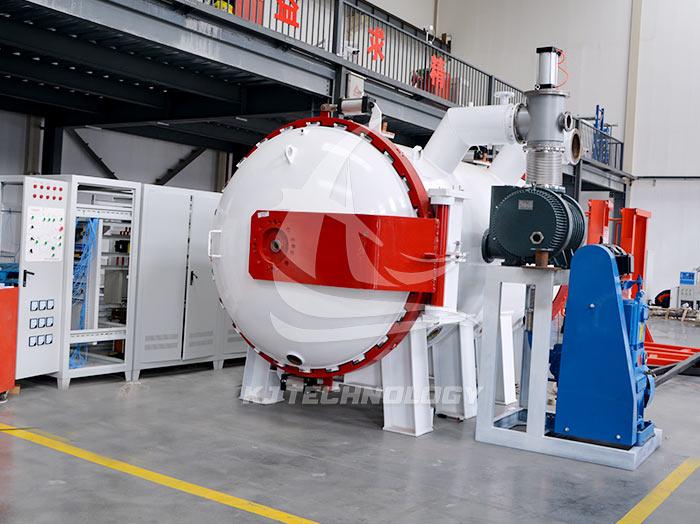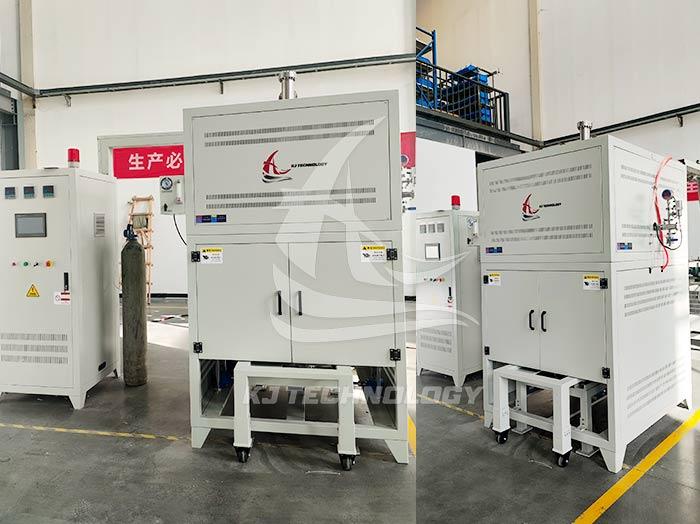Can high vacuum and high temperature muffle furnace be brazed?
 09-16-2025 Author: KJ technology
09-16-2025 Author: KJ technology
The high vacuum and high temperature muffle furnace can be used for brazing, especially in scenarios that require high-precision and high-quality welding. Its principles, advantages, and typical applications are as follows:
1. The brazing principle of high vacuum and high temperature muffle furnace
Vacuum environment inhibits oxidation
Under vacuum conditions (with a maximum vacuum degree of 8.0 × 10 ⁻⁴ Pa), the contact between the metal material and oxygen during brazing is significantly reduced, effectively preventing oxidation reactions from occurring. This is crucial for welding easily oxidizable metals such as aluminum, titanium, and copper, as it can avoid welding defects (such as pores and cracks) caused by oxide layers.
High temperature promotes melting and diffusion of brazing materials
The heating temperature range of the muffle furnace is usually 500 ℃ -1800 ℃, and some models can reach over 2000 ℃, which can meet the melting needs of various brazing materials (such as silver based brazing materials with a melting point of about 780 ℃ and aluminum based brazing materials with a melting point of about 577 ℃). In high temperature environments, the brazing material melts and fully fills the gaps between the parts to be welded, and achieves atomic level diffusion bonding with the base material to form high-strength joints.
Uniform heating and precise temperature control
By optimizing the furnace body design and heating element layout, the muffle furnace can achieve temperature uniformity within ± 3 ℃ (9-point temperature measurement in an empty furnace at 900 ℃), and is equipped with a PID intelligent temperature control system with a temperature control accuracy of ± 1 ℃, ensuring the repeatability and stability of the brazing process.
2. Advantages of high vacuum and high temperature muffle furnace brazing
High quality welded joints
No oxidation, no pollution: The vacuum environment can avoid defects such as porosity and slag inclusion during the welding process, and the joint surface is bright without further treatment.
High strength and sealing: The diffusion bonding between the brazing material and the base material is more complete, and the welding strength is significantly improved. For example, vacuum brazed titanium alloy joints have higher tensile strength and are suitable for high stress scenarios such as aerospace engine components.
Small deformation: The deformation of vacuum brazed workpieces is usually smaller, meeting the processing requirements of precision parts.
Adaptable
Wide material compatibility: suitable for welding of the same or different metals such as stainless steel, high-temperature alloys, heat-resistant alloys, titanium alloys, aluminum, copper, etc. It can also be used for connecting metals with non-metallic materials such as ceramics and graphite.
Complex structure welding: It can achieve multiple brazing seams and simultaneous welding of multiple components, improving production efficiency. For example, vacuum brazing of a certain cooler can complete the connection of multiple heat dissipation units at once.
High process controllability
Accurate control of temperature curve: By programming the heating rate, holding time, and cooling rate, the brazing process parameters can be optimized. For example, the brazing of aluminum based brazing materials requires strict control of the heating rate (≤ 10 ℃/minute) to avoid cracks caused by thermal stress.
Flexible atmosphere protection: Some muffle furnaces support the filling of inert gases (such as argon) to further suppress oxidation, making them suitable for materials sensitive to the atmosphere (such as active metal titanium).
3. Typical application of high vacuum and high temperature muffle furnace brazing
aerospace field
Engine components: Vacuum brazing is used to connect high-temperature alloy components such as turbine blades, combustion chambers, fuel nozzles, etc., ensuring the reliability of the joints in extreme environments.
Thermal protection system: brazing ceramic metal composite materials to prepare spacecraft thermal shields, capable of withstanding high-temperature airflow erosion during re-entry into the atmosphere.
Electronic packaging field
Integrated circuit packaging: Vacuum brazing is used to connect ceramic substrates to metal frames, meeting the requirements of high-density packaging for airtightness and thermal conductivity.
Sensor manufacturing: brazing metal shells and ceramic sensitive components to ensure the stability of sensors in harsh environments.
Automotive manufacturing field
Exhaust system: Vacuum brazed components such as turbochargers and heat exchangers are manufactured to withstand the erosion of high-temperature exhaust gases and corrosive media.
New energy vehicles: brazed battery cooling plates and motor controller cooling modules to improve energy utilization efficiency.
new energy sector
Nuclear reactor components: vacuum brazed connection of nuclear fuel cladding, control rod drive mechanism, etc., to ensure long-term stability under strong radiation and high temperature.
Solar collector: brazed copper stainless steel dissimilar metal joints to improve heat collection efficiency and service life.








